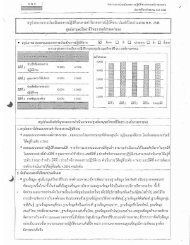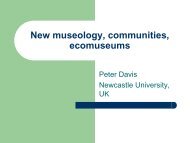Download
Download
Download
Create successful ePaper yourself
Turn your PDF publications into a flip-book with our unique Google optimized e-Paper software.
gaze is constantlyupon the characters,determining what is tobe recorded and howit should be focalized.As such, there is thetendency for a filmmakerto present one worldviewor narrative over all thepossible others, and itis only through a criticalawareness of such“Indeed, one of the core challengesof this kind of collaborativedocumentary production is tobalance the ethics of respecting theprivacy and personal boundariesof the individual characters withthe aims of reaching a wideraudience with a compelling film.”power relations that one can present a more sensitive,nonjudgmental account of the context. Throughout theproduction, we tried to maintain an acute awarenessof this issue in order to transcend the surfaces andreach the underlying human connection. Because of thecollaborative engagement with local culture bearers suchas Chaimongkol, I believe we were quite successful atavoiding any exotic or orientalist representations of theethnic Northern Khmer.Mr.Chaimongkol children playing at Ta Lon’s houseWhen it came to appearing on camera, the peopleof Surin were surprisingly relaxed and well-spoken, as longas we avoided certain sensitive issues that were viewedas potentially detrimental to their social or vocationalpositions. Some of the interviewees spoke their mindswhen the camera was not around, but refused to do soon record. On issues regarding state policies towardsmother tongue language acquisition in school, mostpreferred to voice their official positions rather than theirpersonal opinion. This was a significant challenge for ourproject. A documentary film succeeds when it representsthe reality of a given situation in all its complexity, whichoften means includingopposing perspectives.However, since someof the participants didnot feel comfortablespeaking openly, theirvoices were not fullyrepresented, making itdifficult to portray thesituation. Indeed, one ofthe core challenges ofthis kind of collaborativedocumentary production is to balance the ethics ofrespecting the privacy and personal boundaries of theindividual characters with the aims of reaching a wideraudience with a compelling film.Unlike a fictional film, the narrative structure ofa documentary is not prewritten, but rather discoveredduring and after production—carved out on the editingtable from the recorded footage. Although the filmmakersmust sketch a preliminary plan, it only acts as a generalguideline, and is constantly modified to accommodatethe changing situation. In terms of structure, mostdocumentary films do not have an ending in its classicalnarrative sense. There is no clear resolution, and, indeed,that is the power of documentary; to raise a question ratherthan giving an answer. The narrative of a documentaryis more or less post-modern, related through variousvoices, which sometimes can be incompatible, unreliableor incomplete. It is left to the viewers to draw their ownconclusions and interpretations of the story.Finally, time is an essential necessity for adocumentary project, since different pieces are foundrather than recreated. The filmmaker needs to be at theright place at the right time to be able to witness whatis deemed relevant to the story. Since these meaningfulmoments often occur unexpectedly, a great deal of timemust be spent in the field with the characters in order tobuild rapport and glean the valuable moments as theyoccur. A lot of time is also needed for editing, since againthe story needs to be found and shaped from what isrecorded. An organic story is lying there in the film rushesto be found and thus brought to life.11







